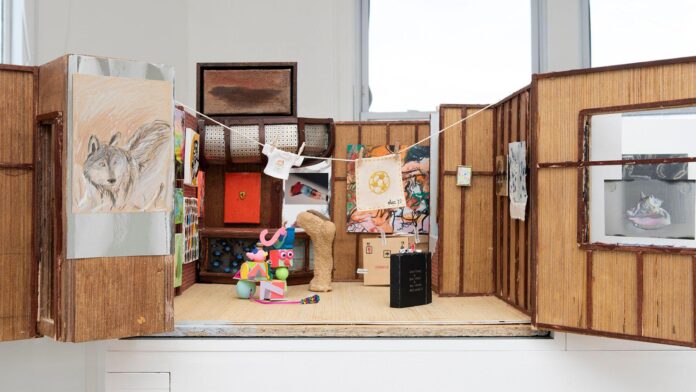The world’s only international art fair for miniature art—shown in mini-stands fit for rodent-size visitors—is bigger than ever. Held in Chicago during Expo Art Week, Barely Fair is hosting its third edition (14-23 April), with a longer roster, an expanded international presence and a generously sized venue for a growing audience. Its goal, however, remains the same as in years past: highlight artist-run and small galleries while building an alternative fair model for affordable art.
The idea to tout art that can fit in one’s palm came from the co-directors of Julius Caesar gallery, a veteran of Chicago’s artist-run-space scene. In 2019, they launched the inaugural Barely Fair at their gallery, inviting visitors to peer inside 24 shoebox-sized mini-stands, each built to one-twelfth of the scale of a typical fair stand and laid out on tables in neat rows. In 2021, returning from a pandemic hiatus, the fair moved into a room at the community hub Color Club to accommodate six more galleries, plus buyers and beholders. But that space, too, was cramped. “There was a line to get in all night,” says Julius Caesar’s Kate Sierzputowski, who is also the director of programming of Expo. “We had 1,000 people at the opening.”

The Blum & Poe stand at Barely Fair 2022 featured works by Tony Lewis and Dave Mueller. Roland Miller
This year, Barely Fair takes over a grand ballroom at Color Club, even though its overall physical footprint is still just over three feet by ten feet. Thirty-six galleries are participating; newcomers include Cob Gallery and Harlesden High Street from London, Scherben from Berlin and Tatjana Pieters from Ghent. The fair’s organisers have also invited commercial spaces to participate (Blum & Poe had a stand last year), in part to help to offset costs. Following a sliding-scale payment system, artist-run spaces pay $150 for a scaled-down stand, while commercial spaces pay $1,500.
Different sets of collectors
The inclusion of more established galleries also helps with fair promotion and attracts different sets of collectors who may then be introduced to lesser-known spaces. “The first year was definitely our trial run,” Sierzputowski says. “We didn’t have many connections, and it was really more about this novelty of being small and seeing who in town for Expo and the New Art Dealers Alliance fair could be attracted. But I think that the longer we’re around, the more serious collectors come. We’ve really been trying to build our collector list.”

Barely Fair’s 2022 edition featured stands by Massimo De Carlo with a work by Rob Pruitt, Corbett vs Dempsey with Diane Simpson, Left Field Gallery with Ben Sanders, Good Weather Gallery with Dylan Spaysky and Pickleman showing Yoko Ono and Robert Gober. Roland Miller
For April April, an independent gallery in New York, Barely Fair offers an opportunity to meet and “deepen dialogue with like-minded peers”, says its co-founder Patrick Bova. For its debut stand, the gallery is presenting an installation of tiny chairs and drawings by the Singapore-based artist Lai Yu Tong, whose work explores emotions within the mundane. “We’ve admired Barely Fair’s past editions for its unique parameters and capacious spirit,” Bova says. “We love inching around what’s possible in a tight space; so many projects that we’re excited by thrive at this scale.”
Barely Fair’s organisers have goals to eventually take the event to other cities, but they also want to stay true to its roots. “Each year, we learn more about how to create and sustain an equitable fair that uses scale to democratise the fair structure,” Sierzputowski says. “The more we expand, the more it becomes like a traditional fair, which we’re attempting to subvert, and you start to have all the same issues. So the more that we keep it tiny, the better.”
- Barely Fair, 14-23 April, Color Club, Chicago

























